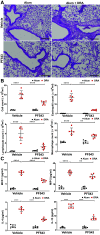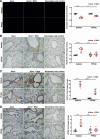Sphingosine kinase 1-specific inhibitor PF543 reduces goblet cell metaplasia of bronchial epithelium in an acute asthma model
- PMID: 38290992
- PMCID: PMC11281799
- DOI: 10.1152/ajplung.00269.2023
Sphingosine kinase 1-specific inhibitor PF543 reduces goblet cell metaplasia of bronchial epithelium in an acute asthma model
Abstract
Sphingosine kinase 1 (SPHK1) has been shown to play a key role in the pathogenesis of asthma where SPHK1-generated sphingosine-1-phosphate (S1P) is known to mediate innate and adaptive immunity while promoting mast cell degranulation. Goblet cell metaplasia (GCM) contributes to airway obstruction in asthma and has been demonstrated in animal models. We investigated the role of PF543, a SPHK1-specific inhibitor, in preventing the pathogenesis of GCM using a murine (C57BL/6) model of allergen-induced acute asthma. Treatment with PF543 before triple allergen exposure (DRA: House dust mite, Ragweed pollen, and Aspergillus) reduced inflammation, eosinophilic response, and GCM followed by reduced airway hyperreactivity to intravenous methacholine. Furthermore, DRA exposure was associated with increased expression of SPHK1 in the airway epithelium which was reduced by PF543. DRA-induced reduction of acetylated α-tubulin in airway epithelium was associated with an increased expression of NOTCH2 and SPDEF which was prevented by PF543. In vitro studies using human primary airway epithelial cells showed that inhibition of SPHK1 using PF543 prevented an allergen-induced increase of both NOTCH2 and SPDEF. siRNA silencing of SPHK1 prevented the allergen-induced increase of both NOTCH2 and SPDEF. NOTCH2 silencing was associated with a reduction of SPDEF but not that of SPHK1 upon allergen exposure. Our studies demonstrate that inhibition of SPHK1 protected allergen-challenged airways by preventing GCM and airway hyperreactivity, associated with downregulation of the NOTCH2-SPDEF signaling pathway. This suggests a potential novel link between SPHK1, GCM, and airway remodeling in asthma.NEW & NOTEWORTHY The role of SPHK1-specific inhibitor, PF543, in preventing goblet cell metaplasia (GCM) and airway hyperreactivity (AHR) is established in an allergen-induced mouse model. This protection was associated with the downregulation of NOTCH2-SPDEF signaling pathway, suggesting a novel link between SPHK1, GCM, and AHR.
Keywords: PF543; airway epithelium; asthma; goblet cell metaplasia; sphingosine kinases.
Conflict of interest statement
No conflicts of interest, financial or otherwise, are declared by the authors.
Figures









Similar articles
-
Possible Involvement of Lysophospholipids in Severe Asthma as Novel Lipid Mediators.Biomolecules. 2025 Jan 27;15(2):182. doi: 10.3390/biom15020182. Biomolecules. 2025. PMID: 40001485 Free PMC article. Review.
-
Neonatal therapy with PF543, a sphingosine kinase 1 inhibitor, ameliorates hyperoxia-induced airway remodeling in a murine model of bronchopulmonary dysplasia.Am J Physiol Lung Cell Mol Physiol. 2020 Sep 1;319(3):L497-L512. doi: 10.1152/ajplung.00169.2020. Epub 2020 Jul 22. Am J Physiol Lung Cell Mol Physiol. 2020. PMID: 32697651 Free PMC article.
-
A specific sphingosine kinase 1 inhibitor attenuates airway hyperresponsiveness and inflammation in a mast cell-dependent murine model of allergic asthma.J Allergy Clin Immunol. 2013 Feb;131(2):501-11.e1. doi: 10.1016/j.jaci.2012.07.014. Epub 2012 Aug 30. J Allergy Clin Immunol. 2013. PMID: 22939756 Free PMC article.
-
Sphingosine Kinase 1/S1P Signaling Contributes to Pulmonary Fibrosis by Activating Hippo/YAP Pathway and Mitochondrial Reactive Oxygen Species in Lung Fibroblasts.Int J Mol Sci. 2020 Mar 17;21(6):2064. doi: 10.3390/ijms21062064. Int J Mol Sci. 2020. PMID: 32192225 Free PMC article.
-
Cardiovascular Effects of Pharmacological Targeting of Sphingosine Kinase 1.Hypertension. 2020 Feb;75(2):383-392. doi: 10.1161/HYPERTENSIONAHA.119.13450. Epub 2019 Dec 16. Hypertension. 2020. PMID: 31838904 Free PMC article.
Cited by
-
Possible Involvement of Lysophospholipids in Severe Asthma as Novel Lipid Mediators.Biomolecules. 2025 Jan 27;15(2):182. doi: 10.3390/biom15020182. Biomolecules. 2025. PMID: 40001485 Free PMC article. Review.
-
Linking Lipid Metabolism and Immune Function: New Insights into Chronic Respiratory Diseases.Pathophysiology. 2025 Jun 6;32(2):26. doi: 10.3390/pathophysiology32020026. Pathophysiology. 2025. PMID: 40559469 Free PMC article. Review.
References
MeSH terms
Substances
Grants and funding
LinkOut - more resources
Full Text Sources
Medical
Miscellaneous

